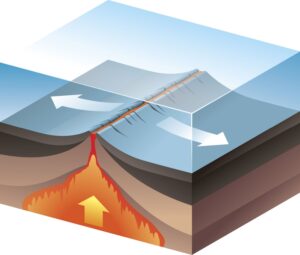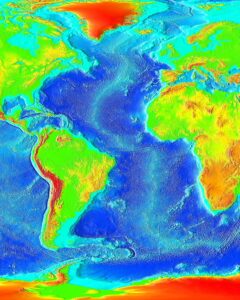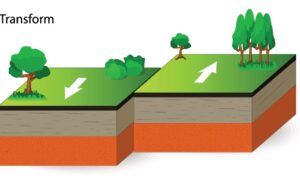Tectonic Plate Theory
1. Introduction to Plate Tectonics:
- Plate tectonics is a unifying theory in geology that explains the dynamics and movements of the Earth’s lithosphere.
- It provides a framework for understanding various geological phenomena such as earthquakes, volcanic eruptions, mountain building, and the distribution of continents and oceans.
2. Components of Plate Tectonics:
- Lithospheric Plates: Earth’s lithosphere is divided into several major and minor plates, which are rigid segments of the Earth’s crust and upper mantle.
- Asthenosphere: Beneath the lithosphere lies the asthenosphere, a semi-fluid layer of the mantle that facilitates the movement of lithospheric plates.
4. Driving Mechanisms:
- Mantle Convection: Heat from Earth’s core drives convection currents in the mantle, which drag and push the overlying lithospheric plates.
- Ridge Push: Newly formed oceanic crust at mid-ocean ridges is elevated and pushes older crust away from the ridge axis.
- Slab Pull: The sinking of dense oceanic lithosphere at subduction zones pulls the trailing lithosphere into the mantle.
5. Evidence for Plate Tectonics:
- Palaeomagnetism: Magnetic minerals in rocks record the Earth’s magnetic field, providing evidence for seafloor spreading and continental drift.
- Fossil Distribution: Similar fossils and geological formations found on separate continents suggest past connections.
- Seafloor Spreading: Age progression of oceanic crust away from mid-ocean ridges supports the theory of plate tectonics.
- GPS and Satellite Data: Modern technology allows for precise measurement of plate movements and deformation.
6. Geological Features and Phenomena:
- Earthquakes: Occur along plate boundaries and faults due to the movement of lithospheric plates.
- Volcanism: Results from the melting of mantle material at subduction zones, hotspots, and divergent boundaries.
- Mountain Building: Collision of continental plates leads to the uplift and formation of mountain ranges.
- Rift Zones: Divergent boundaries on continents can lead to the formation of rift valleys and new ocean basins.
Tectonic plate theory describes the movement and interaction of large, rigid plates that make up the Earth’s lithosphere, the outermost layer of the Earth. These plates are in constant motion, driven by the heat from Earth’s interior and the gravitational forces within the planet. There are several types of interactions between tectonic plates, which include:
- Divergent Boundaries: At divergent boundaries, tectonic plates move away from each other. This movement creates a gap where the magma from the mantle can rise, solidify, and create a new crust. Divergent boundaries often occur along mid-ocean ridges, where new oceanic crust forms as the plates pull apart. An example of this is the Mid-Atlantic Ridge.


- Convergent Boundaries: Convergent boundaries are where tectonic plates move toward each other. When two plates collide, one plate may be forced beneath the other in a process known as subduction. Subduction zones are often characterized by deep ocean trenches and volcanic activity. Alternatively, when two continental plates collide, they may crumple and fold, creating mountain ranges. The Himalayas are a result of the collision between the Indian Plate and the Eurasian Plate.


- Transform Boundaries: At transform boundaries, tectonic plates slide past each other horizontally. This movement can cause earthquakes along the boundary. One of the most famous transform boundaries is the San Andreas Fault in California.
